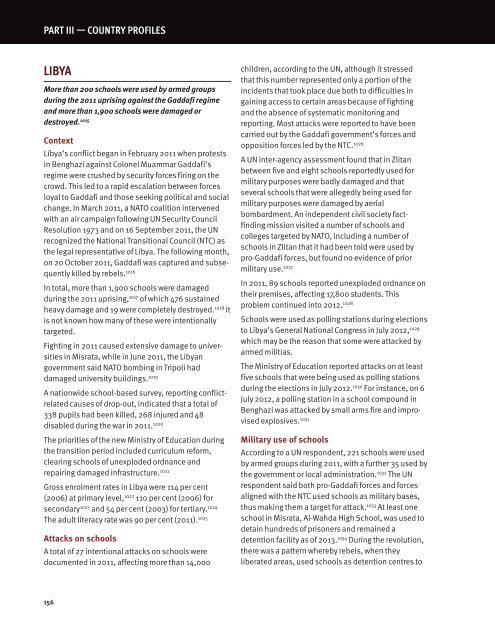eua_2014_full.pdf?utm_content=buffer4a392&utm_medium=social&utm_source=twitter
eua_2014_full.pdf?utm_content=buffer4a392&utm_medium=social&utm_source=twitter
eua_2014_full.pdf?utm_content=buffer4a392&utm_medium=social&utm_source=twitter
- No tags were found...
You also want an ePaper? Increase the reach of your titles
YUMPU automatically turns print PDFs into web optimized ePapers that Google loves.
PART III — COUNTRY PROFILeSLIBYAMore than 200 schools were used by armed groupsduring the 2011 uprising against the Gaddafi regimeand more than 1,900 schools were damaged ordestroyed. 1015ContextLibya’s conflict began in February 2011 when protestsin Benghazi against Colonel Muammar Gaddafi’sregime were crushed by security forces firing on thecrowd. This led to a rapid escalation between forcesloyal to Gaddafi and those seeking political and socialchange. In March 2011, a NATO coalition intervenedwith an air campaign following UN Security CouncilResolution 1973 and on 16 September 2011, the UNrecognized the National Transitional Council (NTC) asthe legal representative of Libya. The following month,on 20 October 2011, Gaddafi was captured and subsequentlykilled by rebels. 1016In total, more than 1,900 schools were damagedduring the 2011 uprising, 1017 of which 476 sustainedheavy damage and 19 were completely destroyed. 1018 Itis not known how many of these were intentionallytargeted.Fighting in 2011 caused extensive damage to universitiesin Misrata, while in June 2011, the Libyangovernment said NATO bombing in Tripoli haddamaged university buildings. 1019A nationwide school-based survey, reporting conflictrelatedcauses of drop-out, indicated that a total of338 pupils had been killed, 268 injured and 48disabled during the war in 2011. 1020The priorities of the new Ministry of Education duringthe transition period included curriculum reform,clearing schools of unexploded ordnance andrepairing damaged infrastructure. 1021Gross enrolment rates in Libya were 114 per cent(2006) at primary level, 1022 110 per cent (2006) forsecondary 1023 and 54 per cent (2003) for tertiary. 1024The adult literacy rate was 90 per cent (2011). 1025Attacks on schoolsA total of 27 intentional attacks on schools weredocumented in 2011, affecting more than 14,000children, according to the UN, although it stressedthat this number represented only a portion of theincidents that took place due both to difficulties ingaining access to certain areas because of fightingand the absence of systematic monitoring andreporting. Most attacks were reported to have beencarried out by the Gaddafi government’s forces andopposition forces led by the NTC. 1026A UN inter-agency assessment found that in Zlitanbetween five and eight schools reportedly used formilitary purposes were badly damaged and thatseveral schools that were allegedly being used formilitary purposes were damaged by aerialbombardment. An independent civil society factfindingmission visited a number of schools andcolleges targeted by NATO, including a number ofschools in Zlitan that it had been told were used bypro-Gaddafi forces, but found no evidence of priormilitary use. 1027In 2011, 89 schools reported unexploded ordnance ontheir premises, affecting 17,800 students. Thisproblem continued into 2012. 1028Schools were used as polling stations during electionsto Libya’s General National Congress in July 2012, 1029which may be the reason that some were attacked byarmed militias.The Ministry of Education reported attacks on at leastfive schools that were being used as polling stationsduring the elections in July 2012. 1030 For instance, on 6July 2012, a polling station in a school compound inBenghazi was attacked by small arms fire and improvisedexplosives. 1031Military use of schoolsAccording to a UN respondent, 221 schools were usedby armed groups during 2011, with a further 35 used bythe government or local administration. 1032 The UNrespondent said both pro-Gaddafi forces and forcesaligned with the NTC used schools as military bases,thus making them a target for attack. 1033 At least oneschool in Misrata, Al-Wahda High School, was used todetain hundreds of prisoners and remained adetention facility as of 2013. 1034 During the revolution,there was a pattern whereby rebels, when theyliberated areas, used schools as detention centres to156


